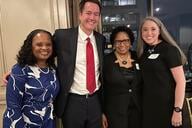You have /5 articles left.
Sign up for a free account or log in.
Layoffs. Buyouts. Closings. Yes, we have all heard of the decimation of the once-powerful mainstream media outlets and the rise of alternative methods of gathering and disseminating news. But, to those of us who spend much of our working hours trying to get reporters to write and say nice things about our students, our faculty and our institutions in general, I say this: There is still life left in what we do.
While the unfiltered, direct contact with audiences allowed by today’s tools are indispensable, that very filter gives media placements their legitimacy. That’s why it’s called third-party validation.
Those who understand that validation recognize that educational institutions are, in essence, not much different than any other business or service. They need to attract new customers (students), retain established ones (alumni and donors), sell products and services (courses, programs and events), recruit superior talent (faculty and staff), maintain their brands and reputations (by showcasing innovation and thought leadership), attract investment and operating capital (by obtaining research funding) and stay ahead of the competition (through rankings).
The difficulties lie in getting buy-in. The relationship between the in-house communications person and the faculty is unlike the agency-client relationship. There, the client must work with the agency, which it is paying to obtain coverage. Here, your average professor, dean, vice president or president may not want to be bothered.
One who does is Fordham University’s Paul Levinson, the author of New New Media (Pearson, 2014).
"Media relations play a crucial role to both universities and the world at large. Faculty do more than teach; they're constantly thinking and sometimes writing about the pressing issues of the day,” he said. “Media relations play a crucial in getting those thoughts out to the mass media and thus the public. Even in this age of social media, the mass media are still an important source of information for a well-informed public."
But not all faculty embrace media in the way that Levinson does. In my experience, five to 10 percent of your faculty is responsible for 90 percent of your earned media coverage. You always want to strive for more, but that’s a pretty good ratio.
As we all know, earned media supplement an institution’s marketing efforts by formulating and implementing strategies that aim to: highlight student and alumni achievements in various industries, and in DMAs with significant pools of alumni and potential donors; attain exposure for its faculty members, their teaching and their research; develop institutional feature stories as evidenced by accomplishments in various disciplines; and promote the institution’s good news to local, regional, national and international news media.
Given all this, one might ask, why is there such a low rate of participation?
The answer is that the nature of the academy is not conducive to such participation. Professors are busy. They have enough to do, so why prepare for an interview, spend a lot of time doing it, yet run the risk of only having a brief sound bite included – or, worse, being excluded altogether? Besides, they don’t get paid for it and it often doesn’t count toward tenure or post-tenure review.
That’s where the PR person should articulate how media exposure is good for everyone: the faculty member, the department and the institution. That exposure attracts attention which, if marketed properly, attracts students, faculty, staff, funding and other elements that keep the place running.
“Scholarly activity is only advanced by having relevant comment by faculty in media,” said Robert Boland, a longtime NYU professor who now directs the Master of Sports Administration Program at Ohio University. “It focuses attention on the extraordinary work going on in the academy and, each time a faculty member appears as a credible expert, (it) underscores the value of that work.”
A case can also be made that becoming a thought leader – or public intellectual, if one prefers – offers tangible personal and professional benefits.
“Writing for the public sphere and exposing your ideas to public scrutiny can have more effect than peer review,” said Daniel DiSalvo, a City College of New York political scientist and Manhattan Institute fellow. “Academics needs to test their ideas in a hard hitting, fast moving media environment, as your research may be enough for news but not enough for peer review. The resulting reactions can advance your scholarly agenda.”
Beyond selfish reasons, some academics believe that it is important for them to contribute their perspectives on their research interests as a means of seeking better understanding of issues.
One of them is Laura Gonzalez, an associate finance professor at California State University at Long Beach, who arrived in the U.S. from Spain in 2008 with no previous media experience. Now a sought-out media commentator on important macro-economic issues, she believes that this aspect of her job is an extension of what she does as a teacher and researcher.
“Academics can assist in the discussion of topics that are relevant to society,” she said. “Full, open informed discussions are what keep democracy resilient and effective.”
Syd Steinhardt (syd@steinhardtmedia.com) is a communications consultant to higher education and nonprofit institutions. He has held senior public relations positions at the City College of New York, New York University and Fordham University.




